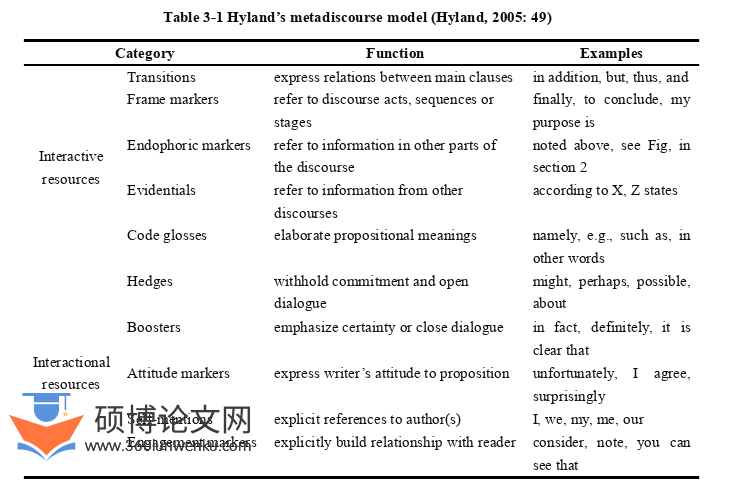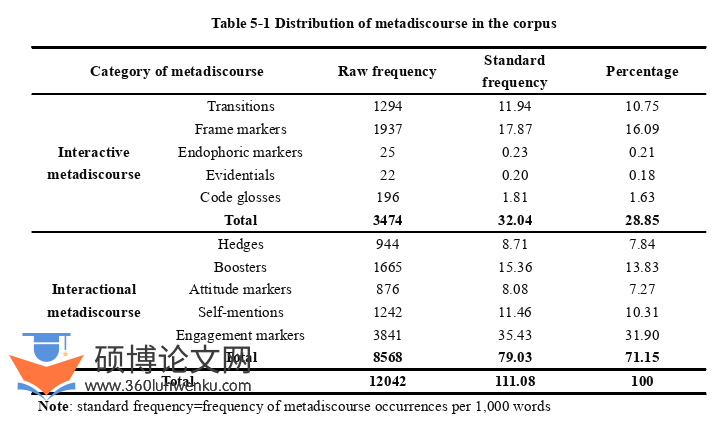本文是一篇语言学论文,本研究从淘宝平台选取8个小时的电商直播视频自建语料库,对电商直播中主播元话语的使用情况进行分析。本文采用海兰德提出的元话语人际模式作为元话语的分类和鉴别系统,并借鉴了亚里士多德的修辞劝说理论进行进一步的定性分析。
Chapter One Introduction
1.1 Research Background
In 1959,“metadiscourse”originated as a term by the structural linguist Harris,who regarded it as a tool for understanding language in use.It is generally believedthat discourse consists of two levels:primary discourse and metadiscourse.Primarydiscourse,recognized as the expression of propositional information,is propositional,while metadiscourse,characterized as the evaluation and narration of propositionalinformation,is non-propositional(Crismore,1989).The use of metadiscourse arisesfrom speakers’consideration of their audience,which helps to promote the interactionbetween the two sides effectively.Metadiscourse functions to not only facilitate thecommunication of the speaker’s concerns,viewpoints,and assessments throughdiscourse,but also to improve the structure of discourse while anticipating possibleresponses from the audience.According to Hyland(2005),metadiscourse contributesto the realization of rational,credible and affective appeals proposed by Aristotle(1991).In other words,metadiscourse is related to rhetoric and is conducive toorganizing discourse,expressing views,and building a good relationship with the audience.

语言学论文怎么写
............................
1.2 Research Objectives and Significance
Recently,metadiscourse in various written discourses has received sustainedattention.However,despite the considerable focus on written forms,metadiscourse inspoken genres,particularly within e-commerce livestreaming,has largely beenoverlooked.Therefore,this research strives to bridge the gap by exploring theapplication of metadiscourse in the context of e-commerce livestreaming.To bespecific,the features of streamers’metadiscourse,including the types,distributionpatterns,and specific linguistic features,are investigated under Hyland’s(2005)taxonomy of metadiscourse.Moreover,the persuasive functions of such linguisticresources are investigated under Aristotle’s(1991)theory of rhetorical persuasion.
The research questions of this study are as follows:
(1)What are the types and distribution of streamers’metadiscourse ine-commerce livestreaming?
(2)How does streamers’metadiscourse achieve persuasive functions ine-commerce livestreaming?
With regard to research significance,both theoretical value and practicalimportance can be embodied by the present study.
Theoretically speaking,this study is expected to expand the research scope andapplication of metadiscourse,as limited attention has been given to metadiscoursewithin spoken discourse,especially in e-commerce livestreaming.Hyland(2005)contends that it is essential to inquire into metadiscourse applied in various textsbeyond academic genres.Furthermore,research on metadiscourse from theperspective of rhetorical persuasion is relatively insufficient.Accordingly,this studymay shed some light on the connections between metadiscourse and persuasion.
...........................
Chapter Two Literature Review
2.1 Previous Studies on Metadiscourse
Since its introduction,the critical concept of“metadiscourse”has become a researchhotspot at home and abroad.The extensive contributions from scholars have maintainedmetadiscourse research popular today.Before conducting in-depth research,it is essential tounderstand the definitions and classifications of metadiscourse for a better comprehension ofthe concept itself.
2.1.1 Definitions of Metadiscourse
The concept of“metadiscourse”was coined by Harris(1959)to denote information thatexists independently of the primary content within a text,and it was not until the 1980s that itreceived widespread attention under the promotion of scholars.However,owing to thefuzziness,openness,multi-functionality,and context-dependence of metadiscourse(Ädel,2006),it is not easy to pin down the unifying concept of the term.According to Chen Xinren (2020),metadiscourse can be defined from a narrow,relatively broad,and broadestperspective.
Metadiscourse,in a limited sense,refers exclusively to linguistic components employedto fulfill textual purposes,advocated by Meyer(1975),Schiffrin(1980),and Mauranen(1993).Meyer(1975:77)proposes“signaling”to elucidate how metadiscourse is crucial in linkingdiscourse structures and conveying semantic content.Schiffrin(1980)regards metadiscourseas a kind of“metatalk”that can be used to organize and evaluate ongoing talk.Mauranen(1993)puts forward the term“metatext”to describe metadiscourse as“text about the text”,further arguing that it has the function of signaling the direction,purpose,and internalstructure of the text,which reflects“discourse reflexivity”.
.........................
2.2 Previous Studies on the Persuasive Functions of Metadiscourse
Despite variations in scholars’perspectives regarding the definition and categorization of metadiscourse,there is consensus that it is closely connected with the intentions of writers orspeakers.The reason is that metadiscourse plays a pivotal role in enabling writers or speakersto structure their texts and ideas coherently,demonstrating their positive qualities like honesty,competence,and authority effectively,and exhibiting consideration and respect for theiraudience successfully.Hyland(2005)points out that metadiscourse facilitates rational,credible,and affective appeals.Numerous scholars,both at home and abroad,have researchedthe persuasive functions of metadiscourse in various types of discourse.
2.2.1 Persuasive Functions of Metadiscourse in Written Genre
By reviewing previous studies,it is found that research on the persuasive functions ofmetadiscourse is mainly focused on written genre,specifically in academic writing,businessdiscourse,advertising discourse and newspaper discourse.
2.2.1.1 Academic Writing
Academic writing is commonly recognized as persuasive,with considerable researchdevoted to examining the significant role of metadiscourse in achieving academic persuasion.
..........................
Chapter Three Theoretical Framework.................................25
3.1 Hyland’s Interpersonal Model of Metadiscourse........................25
3.1.1 Interactive Metadiscourse...................................26
3.1.2 Interactional Metadiscourse..............................27
Chapter Four Research Design....................35
4.1 Research Questions....................................35
4.2 Research Methods..........................35
4.3 Data Collection....................................36
Chapter Five Results and Discussions of Metadiscourse in the E-commerceLivestreaming Corpus...............................41
5.1 Types and Distribution of Metadiscourse in the E-commerceLivestreaming Corpus....................41
5.1.1 Overall Distribution of Metadiscourse in the Corpus.................41
5.1.2 Analysis of Subcategories of Metadiscourse in the Corpus........45
Chapter Five Results and Discussions of Metadiscourse in theE-commerce Livestreaming Corpus
5.1 Types and Distribution of Metadiscourse in the E-commerceLivestreaming Corpus
In this section,the overall distribution of streamers’metadiscourse in the corpus is firstpresented.Next,the specific subcategories of metadiscourse in e-commerce livestreaming areexplored,with examples of linguistic representation for each subcategory provided.Thissection addresses the first research question.
5.1.1 Overall Distribution of Metadiscourse in the Corpus
By closely examining the self-built e-commerce livestreaming corpus,metadiscourseresources are identified and classified.This chapter first uses the corpus retrieval toolAntConc 4.2.0 to conduct a statistical analysis of the use of metadiscourse by streamers ine-commerce livestreaming.This indicates the crucial role of metadiscourse in constructingeffective communication in such a context.The specific results are presented in the followingtable:

语言学论文参考
.......................
Chapter Six Conclusion
6.1 Major Findings
Based on the detailed analysis in Chapter Five,the major findings are summarized asfollows:
Firstly,the statistical results show that all the ten subcategories of metadiscourse areobserved in the e-commerce livestreaming corpus.Overall,12,042 instances of metadiscourseare identified in the self-built corpus of 108,411 words,averaging 111.08 occurrences per1,000 words.This indicates its widespread use by streamers.Furthermore,streamers tend touse interactional metadiscourse more frequently than the interactive type,with the quantity ofthe former 2.5 times more than that of the latter.This is mainly due to the interactive andspoken nature of e-commerce livestreaming,highlighting its interpersonal significance.
Specifically,among the ten subcategories,engagement markers emerge as the mostfrequently occurring type,constituting 31.90%of the total instances.This suggests streamers’ strong desire to achieve interactions between them and the target audience.Among them,singular pronouns,endearing vocative expressions,and questions are conducive to invitingthe audience to participate actively in the livestream.The next most commonly usedmetadiscourse is frame markers,which are used to guide the audience’s understanding.Topiccontinual markers stand out prominently within frame markers to maintain the coherence ofthe discourse.Following frame markers are boosters,transitions,and self-mentions,which areemployed to heighten viewers’emotions,structure streamers’discourse and enhance trustwith the audience.As the two ways of adjusting the certainty of discourse,the use of hedges issignificantly lower compared to boosters,hinting streamers’intention to emphasizeconfidence in their discourse.As for other subcategories,the frequencies of code glosses,endophoric markers,and evidentials are relatively low,but they still somewhat influence thelivestreaming effect and viewer experience to some extent.
reference(omitted)
